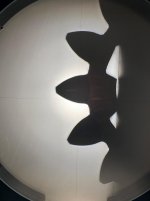Hi all,
Sometimes, you just get lucky. I was fortunate enough come across a Polish-made TUM-35 14x40 lathe this week for the low low price of $350. I'm a home shop guy and have been waiting patiently for a nice machine to come along, so this made my day.
Here's the rub. The motor gearbox had experienced a crash and no longer transmitted power from the motor to the output pulley. Seller advised there was a broken gear, and an inspection confirmed that. Now that the gearbox is home, I've disassembled it partially and extracted the damaged gear.
I was originally hoping to braze a new tooth on and have a local shop machine a new profile. Now I realize that because the wall is so thin, wire EDM is my only choice. Fortunately a friend has access to a wire machine, so my next major task is designing the new part.
Two major questions:
I have access to Solidworks at work, so I can design the new part once I can figure out these dimensions.


Sometimes, you just get lucky. I was fortunate enough come across a Polish-made TUM-35 14x40 lathe this week for the low low price of $350. I'm a home shop guy and have been waiting patiently for a nice machine to come along, so this made my day.
Here's the rub. The motor gearbox had experienced a crash and no longer transmitted power from the motor to the output pulley. Seller advised there was a broken gear, and an inspection confirmed that. Now that the gearbox is home, I've disassembled it partially and extracted the damaged gear.
I was originally hoping to braze a new tooth on and have a local shop machine a new profile. Now I realize that because the wall is so thin, wire EDM is my only choice. Fortunately a friend has access to a wire machine, so my next major task is designing the new part.
Two major questions:
- I believe the spline is a 6x21x25, according to web research. How can I find the details on that spline design? Primarily I'm wondering about angles of the 6 teeth.
- How can I determine the tooth design? I do have access to an optical comparator, if that will help my case. Any pointers here would be helpful.
I have access to Solidworks at work, so I can design the new part once I can figure out these dimensions.












